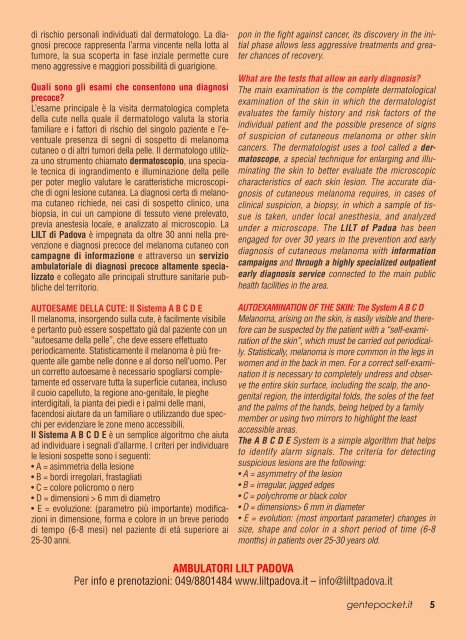Create successful ePaper yourself
Turn your PDF publications into a flip-book with our unique Google optimized e-Paper software.
di rischio personali individuati dal dermatologo. La dia<br />
gnosi precoce rappresenta l’arma vincente nella lotta al<br />
tumore, la sua scoperta in fase inziale permette cure<br />
meno aggressive e maggiori possibilità di guarigione.<br />
Quali sono gli esami che consentono una diagnosi<br />
precoce?<br />
L’esame principale è la visita dermatologica completa<br />
della cute nella quale il dermatologo valuta la storia<br />
familiare e i fattori di rischio del singolo paziente e l’e<br />
ventuale presenza di segni di sospetto di melanoma<br />
cutaneo o di altri tumori della pelle. Il dermatologo utiliz<br />
za uno strumento chiamato dermatoscopio, una specia<br />
le tecnica di ingrandimento e illuminazione della pelle<br />
per poter meglio valutare le caratteristiche microscopi<br />
che di ogni lesione cutanea. La diagnosi certa di melano<br />
ma cutaneo richiede, nei casi di sospetto clinico, una<br />
biopsia, in cui un campione di tessuto viene prelevato,<br />
previa anestesia locale, e analizzato al microscopio. La<br />
LILT di Padova è impegnata da oltre 30 anni nella pre<br />
venzione e diagnosi precoce del melanoma cutaneo con<br />
campagne di informazione e attraverso un servizio<br />
ambulatoriale di diagnosi precoce altamente specializzato<br />
e collegato alle principali strutture sanitarie pub<br />
bliche del territorio.<br />
AUTOESAME DELLA CUTE: Il Sistema A B C D E<br />
Il melanoma, insorgendo sulla cute, è facilmente visibile<br />
e pertanto può essere sospettato già dal paziente con un<br />
“autoesame della pelle”, che deve essere effettuato<br />
periodicamente. Statisticamente il melanoma è più fre<br />
quente alle gambe nelle donne e al dorso nell’uomo. Per<br />
un corretto autoesame è necessario spogliarsi comple<br />
tamente ed osservare tutta la superficie cutanea, incluso<br />
il cuoio capelluto, la regione ano-genitale, le pieghe<br />
interdigitali, la pianta dei piedi e i palmi delle mani,<br />
facendosi aiutare da un familiare o utilizzando due spec<br />
chi per evidenziare le zone meno accessibili.<br />
Il Sistema A B C D E è un semplice algoritmo che aiuta<br />
ad individuare i segnali d’allarme. I criteri per individuare<br />
le lesioni sospette sono i seguenti:<br />
• A = asimmetria della lesione<br />
• B = bordi irregolari, frastagliati<br />
• C = colore policromo o nero<br />
• D = dimensioni > 6 mm di diametro<br />
• E = evoluzione: (parametro più importante) modifica<br />
zioni in dimensione, forma e colore in un breve periodo<br />
di tempo (6-8 mesi) nel paziente di età superiore ai<br />
25-30 anni.<br />
pon in the fight against cancer, its discovery in the initial<br />
phase allows less aggressive treatments and greater<br />
chances of recovery.<br />
What are the tests that allow an early diagnosis?<br />
The main examination is the complete dermatological<br />
examination of the skin in which the dermatologist<br />
evaluates the family history and risk factors of the<br />
individual patient and the possible presence of signs<br />
of suspicion of cutaneous melanoma or other skin<br />
cancers. The dermatologist uses a tool called a dermatoscope,<br />
a special technique for enlarging and illuminating<br />
the skin to better evaluate the microscopic<br />
characteristics of each skin lesion. The accurate diagnosis<br />
of cutaneous melanoma requires, in cases of<br />
clinical suspicion, a biopsy, in which a sample of tissue<br />
is taken, under local anesthesia, and analyzed<br />
under a microscope. The LILT of Padua has been<br />
engaged for over 30 years in the prevention and early<br />
diagnosis of cutaneous melanoma with information<br />
campaigns and through a highly specialized outpatient<br />
early diagnosis service connected to the main public<br />
health facilities in the area.<br />
AUTOEXAMINATION OF THE SKIN: The System A B C D<br />
Melanoma, arising on the skin, is easily visible and therefore<br />
can be suspected by the patient with a “self-examination<br />
of the skin”, which must be carried out periodically.<br />
Statistically, melanoma is more common in the legs in<br />
women and in the back in men. For a correct self-examination<br />
it is necessary to completely undress and observe<br />
the entire skin surface, including the scalp, the anogenital<br />
region, the interdigital folds, the soles of the feet<br />
and the palms of the hands, being helped by a family<br />
member or using two mirrors to highlight the least<br />
accessible areas.<br />
The A B C D E System is a simple algorithm that helps<br />
to identify alarm signals. The criteria for detecting<br />
suspicious lesions are the following:<br />
• A = asymmetry of the lesion<br />
• B = irregular, jagged edges<br />
• C = polychrome or black color<br />
• D = dimensions> 6 mm in diameter<br />
• E = evolution: (most important parameter) changes in<br />
size, shape and color in a short period of time (6-8<br />
months) in patients over 25-30 years old.<br />
AMBULATORI LILT PADOVA<br />
Per info e prenotazioni: 049/8801484 www.liltpadova.it – info@liltpadova.it<br />
gentepocket.it 5



